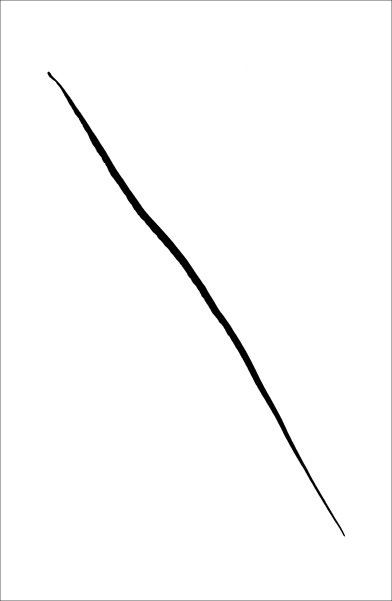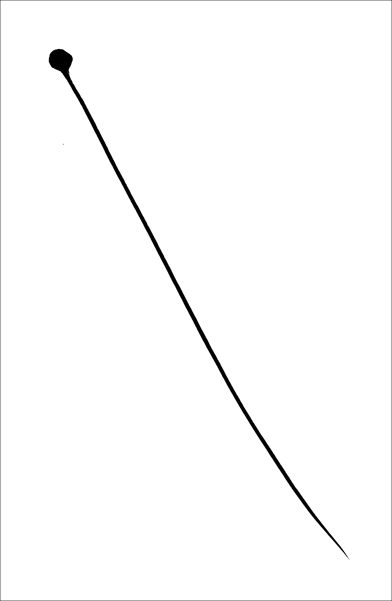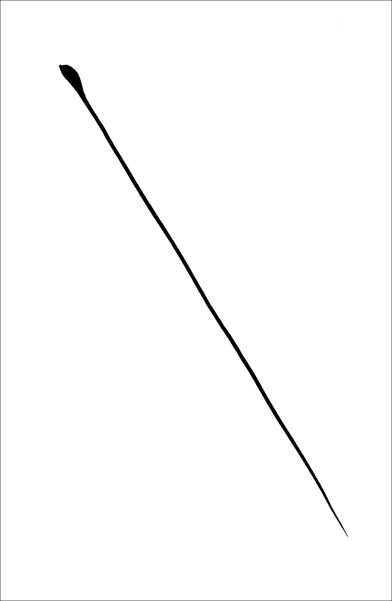by Dr. Gil Dekel.
‘…a drawing of a person in not a real person, but a drawing of a line is a real line’
– Sol LeWitt [1].
Following this declaration by artist Sol Lewitt, I decided to paint a portrait – a portrait of a line…
I was guided to use inks for the portrait of the line. I think that the quality of a ‘running’ liquid was crucial, as ink runs in a straight manner through the quill onto the paper – similar to a line, which runs across the surface. Also, using ink with a quill, the artist can closely control the width of the drawn line.
I made some 50 portraits in all. The first attempts turned out a simple line; starting very thin, widening through the middle, and then narrowing again at the end.
The second phase of the portraits evolved to include a dot as the starting point of the drawing. As I held the quill, hovering and lingering a few centimetres above the card, the ink soon leaked from the quill, dropping on the card; marking the card with a dot. I realised that this is more true to the nature of a line, since a line is made of infinite dots.
As the dot was spontaneously ‘falling’ onto the card, I felt it was not right that the quill was still held above the card, while the ink was falling from it on the card. I felt that the quill must also ‘drop’, following the ink in its free fall, so that both the dropping ink and the quill touch the card at the same time. This, I assume, was ‘designed’ so that the linear flow of the ink in the quill continues until it reaches the card. The portrait of the line does not begin with the ink on the card, but with the ink in the quill, and so the quill had to be lowered down unto the card at the same time as the ink was falling.
I was amazed how such simple activity – using black ink on 15x10cm cards – turned to contain so much wisdom. This was knowledge gained through action.
Being amazed at this, I held the quill firmly on the card; the quill now being in the middle of the dot that the ink created. As I was hesitating with the quill held still for a second or two, more ink ran through unto the card, making the dot larger. I would then draw out (almost pull) the quill across the card, creating the line.
The result was a portrait with a strong solid dot, from which the line sprang. I made about a dozen of such portraits. The experience of holding the quill amidst a puddle of black ink dot felt timeless – similar to the meditative feeling when creating Japanese Calligraphy.
With my experiments of the quill being held in the middle of the dot, I noted that drawing the quill to make the line meant smudging the dot into the line. I realised that the quill does not have to ‘stand’ in the middle of the dot to begin with. It could be placed ‘behind’ the dot (above it, at the top edge of the dot), or ‘before’ the dot (at the lower edge). And from these alternative locations the quill could be then pulled to make the line. I do not remember if I made this test. I think I realised it only after completing the project.
The next phase was to smudge the dot as much as possible to narrow it, almost to the width of the line itself. I felt this is more accurate, since the dots that make a line should not be wider than the line itself.
From the beginning of this project I felt that the line should start narrow, widen up, and narrow again at its end. The narrowing at the end remained all through the portraits samples I created. I think this is because a line, which is made of dots, has no dimension, since dots are ethereal. In the same way, I wanted my line to end narrow into the air, narrowing into the ethereal space.
Further projects could be using acrylics for a line portrait, and creating a portrait of line without showing a line at all.
Reference:
1. Quoted in Dekel. G. (2009) PhD Thesis. ‘Inspiration: a functional approach to creative practice’. Page 16. Retrieved 19 Feb 2018, from: http://www.insight.poeticmind.co.uk/7-literature-review-pt-2-of-4/
21 May 2012. Update 19 Feb 2018. © Gil Dekel.






 - Reading with Natalie, book here...
- Reading with Natalie, book here...